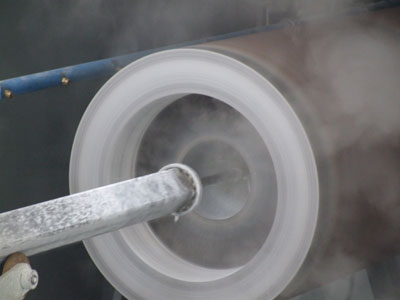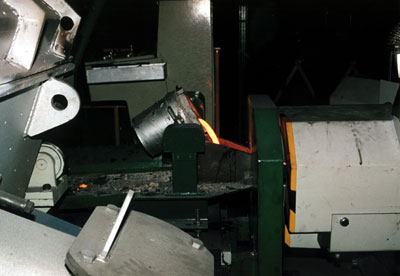A systematic approach to mould preparation will provide long term scrap reduction benefits.
A step-by-step procedure to record parameters in a simple form will allow errors to be identified and eliminated.
Mould Surface Cleanliness
For the best results the mould surface must be completely free from dust traces from the previous cast, failure to completely clean the whole mould surface runs the risk of coating failing for the next cast which can result in sticking castings and or defective casting surfaces.
Mould Temperature
Mould temperature control is important – too low residual moisture may remain, too hot coating could fail or become friable without the operators knowledge resulting in poor casting surfaces. Most alumina or zircon coatings require approximately 200°C – 250°C mould temperatures, Diatomaceous earth coating can require the mould to be pre heated to a higher temperature.
Mould Coating

Mould being Sprayed
Gibson Centri Tech supply both alumina and Silica mould coatings and provide technical information relating to temperature and application. All coatings should be sprayed where possible, using automated spraying equipment.
Shaped moulds can be sprayed using an automated spraying system, but this can be costly. In the hands of a skilled operator the semi-automated method can be satisfactory. A slow rotating mould will enable the operator to control the deposition using a hand spray gun with reasonable accuracy.
Coating is usually applied to a thickness of 1-1½ mm depending upon the surface structure of the coating.
After mould coating pouring of the casting should take place within a short period for the best results.
Mould Maintenance
Moulds should be manufactured from an appropriate material and should be inspected before use and at regular intervals during production.
Fasteners and wedge pins must be maintained in good working condition and sized correctly for their task.
Pouring Spout Preparation
 It has been noticed over many years of visiting foundries, that the pouring horn is the most neglected piece of equipment.
It has been noticed over many years of visiting foundries, that the pouring horn is the most neglected piece of equipment.
Several type of casting defects, inclusions etc, can be attributed to the lack of care with the cleanliness of the pouring spout and the temperatures. The spout must be pre-heated with the refractory surface “red hot” (1000°C) immediately before the pouring operation takes place, this is important to minimise metal retention.
Prior to the pre-heating operation the down tube or pouring spout must be inspected for any metal, slag or loose refractory particles, this can be removed by passing a hard wood rod, down the pouring tube or horn. Metal bars tend to damage the refractory surface and should be avoided.
Coating the pouring spout with a suitable refractory coating will provide a much longer period between re-lining and minimise metal retention after pouring.
